March 2015 LIP of the Month
The Yakutsk-Vilyui LIP of the Siberian Craton
Alexei V. Ivanov, Institute of the Earth’s Crust, Siberian Branch of the Russian Academy of Sciences, Irkutsk, Russia, aivanov@crust.irk.ru
Elena I. Demonterova, Institute of the Earth’s Crust, Siberian Branch of the Russian Academy of Sciences, Irkutsk, Russia, dem@crust.irk.ru
Vladimir E. Pavlov, Institute of Physics of the Earth, Russian Academy of Sciences, Moscow, Russia &3 Kazan Federal University, Kazan, Russia, pavlov-home@rambler.ru
Andrey V. Shatsillo, Institute of Physics of the Earth, Russian Academy of Sciences, Moscow, Russia, shatsillo@gmail.com
Boris B. Kochnev, A.A. Trofimuk Institute of Petroleum Geology and Geophysics, Siberian Branch of the Russian Academy of Sciences, Novosibirsk, Russia, KochnevBB@ipgg.sbras.ru
Introduction
The Siberian Craton is a structure composed of the Paleoarchean to Paleoproterozoic blocks, which were welded together during a Paleoproterozoic episode of magmatism and metamorphism that peaked at about 1.87 Ga (Gladkochub et al. 2006; Rojas-Agramonte et al. 2011). After that time, the Siberian Craton represented a single, large tectonic block, which was a constituent part of the supercontinents Nuna/Columbia (Paleoproterozoic), Rodinia (Mesoproterozoic) and Pangea (Paleozoic) and between the supercontinent cycles it acted as core of a separate continental block referred to as Siberian continent (Cocks and Torsvik, 2007; Li et al., 2008; Domeier and Torsvik, 2014).
In the Phanerozic, the Siberian Craton experienced large volume mafic magmatism at least twice, during Devonian (e.g., Kiselev et al., 2012) and Permian-Triassic (e.g., Ivanov et al., 2013). The Precambrian large igneous provinces on the Siberian Craton are inferred from mafic dyke records. Ernst (2007) argues that mafic/ultramafic dykes with average width of >10 m are indicators for being feeders of a flood basalt province. The Paleoproterozoic dykes are well known within the Siberian Craton (Gladkochub et al., 2010; Ernst et al. 2013; Ernst et al. 2014). Recent data indicates on a ~1 Ga mafic/ultramafic event within the Siberian craton (Ivanov et al., 2012; Savel’eva et al., in press).
The Permian-Triassic Siberian large igneous province is well studied (see http://www.largeigneousprovinces.org/04mar and Ivanov et al., 2013 for the latest review), though it remains enigmatic due to its anomalous size (~7×106 km2) and volume (~4×106 km3) even on the LIP scale (Bryan and Ernst, 2008; Ernst, 2014). The Precambrian large igneous provinces of the Siberian Craton, on contrary, are enigmatic due to poor preservation. The Devonian Yakutsk-Vilyui large igneous province (Y-V LIP) is eroded and its size is inferred from the dyke and sill distribution (Fig. 1). Here we summarize basic information about the Y-V LIP.
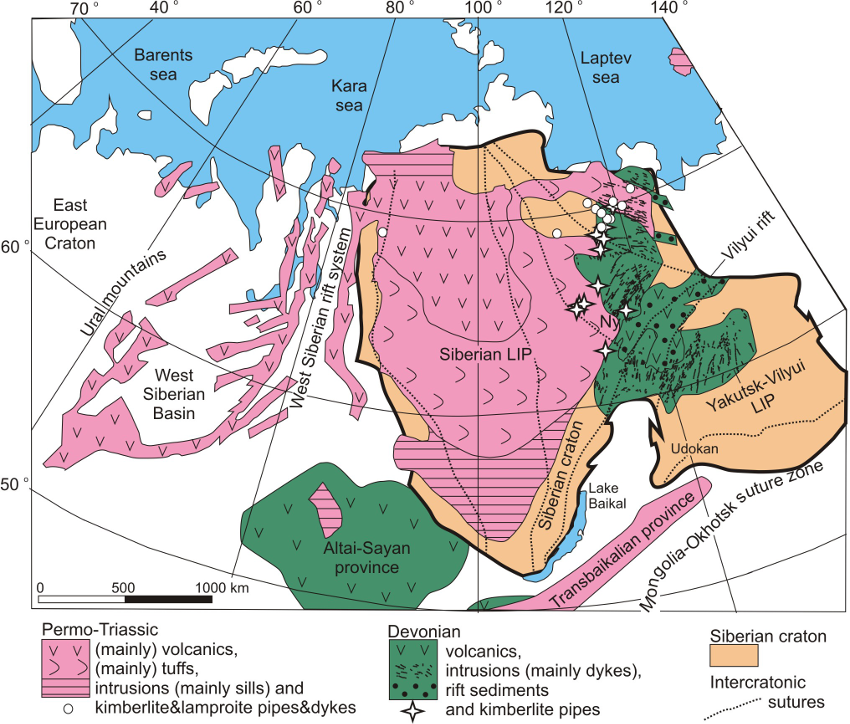
Figure 1: Distribution of Devonian Y-V LIP and Permo-Triassic Siberian LIP. The outlines are from Kiselev et al. (2012) and Ivanov et al. (2013), respectively. Devonian dykes are after Kiselev et al. (2012). Boundary of the Siberian craton is from Rosen et al. (1994) and Smelov and Timofeev (2007). Bold dashed curves are intercratonic sutures after Rosen et al. (1994). Ny – marks position of Nyurba kimberlite with evidence of emplacement between the two Devonian flood basalt pulses (Kiselev et al., 2014). The Altai-Sayan volcanic and Transbaikalian provinces are shown after Vorontsov et al. (2013) and Yarmolyuk et al. (2001), respectively.
Chemistry
Major, trace element and Sr-Nd isotope data for few tens of samples was reported by Kiselev et al. (2012). Volcanic and intrusive rocks of the Y-V LIP are mainly low magnesium basalts of both the high- and low-Ti series. High-Ti basalts are predominant. Typical rock compositions are provided in the Table 1, whose primitive mantle (McDonough and Sun, 1995) normalized incompatible element spectra are shown in Fig. 2. Evolved rocks such as mugearites and benmoreites are also present. The limited compositional variability of the Y-V LIP could be an artefact of the insufficient sampling, however.
Table 1: Selected rock compositions from the Y-V LIP after Kiselev et al. (2012).
|
Series |
High-Ti |
Low-Ti |
|
Sample no. |
12b-00 |
262-2k |
|
SiO2 |
46.7 |
48.25 |
|
TiO2 |
4.88 |
1.76 |
|
Al2O3 |
11.7 |
14.61 |
|
Fe2O3 |
- |
6.32 |
|
FeO |
- |
7.12 |
|
FeOt |
16.11 |
- |
|
MnO |
0.16 |
0.20 |
|
MgO |
5.66 |
6.51 |
|
CaO |
7.71 |
11.74 |
|
Na2O |
2.15 |
2.41 |
|
K2O |
1.54 |
0.38 |
|
P2O5 |
0.7 |
0.13 |
|
LOI |
1.02 |
1.21 |
|
Total |
98.33 |
100.64 |
|
Rb |
36.1 |
9.28 |
|
Sr |
232 |
207 |
|
Y |
62.7 |
27.6 |
|
Zr |
460 |
116 |
|
Nb |
44.0 |
6.98 |
|
Ba |
253 |
246 |
|
La |
62.7 |
6.94 |
|
Ce |
135 |
17.6 |
|
Pr |
15.8 |
3.07 |
|
Nd |
63.6 |
14.5 |
|
Sm |
14.0 |
4.24 |
|
Eu |
3.74 |
1.69 |
|
Gd |
14.1 |
5.35 |
|
Tb |
2.18 |
0.93 |
|
Dy |
12.6 |
6.24 |
|
Ho |
2.50 |
1.35 |
|
Er |
6.23 |
3.91 |
|
Tm |
0.92 |
0.54 |
|
Yb |
5.33 |
3.52 |
|
Lu |
0.74 |
0.47 |
|
Hf |
11.3 |
2.95 |
|
Ta |
2.35 |
0.50 |
|
Pb |
0.53 |
2.06 |
|
Th |
5.05 |
0.81 |
|
U |
1.56 |
0.30 |
|
87Sr/86SrT |
0.70452 |
0.70504 |
|
εNdT |
4.8 |
6.0 |
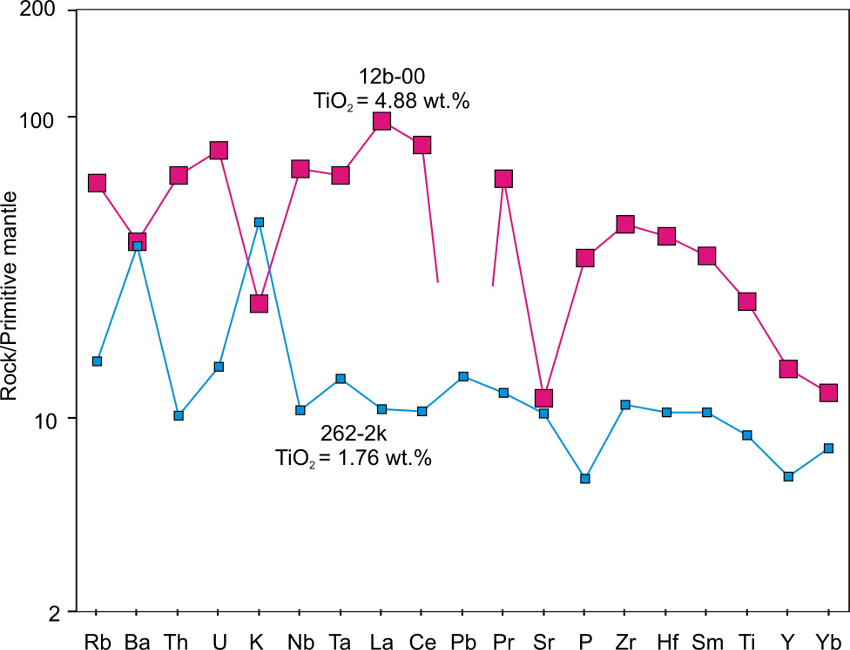
Figure 2: Primitive mantle (McDonough and Sun, 1995) normalized diagram for incompatible elements with selected basalt samples from the Y-V LIP. Sample numbers and TiO2 concentrations are shown close to the corresponding spectra (see Table 1). Pb normalized concentrations are not shown for the sample 12b-00, because of suspicion for the analytical problem in Kiselev et al. (2012).
Geochronology
Geochronologic information is limited in literature. The published ages are mainly 40Ar/39Ar ages (Courtillot et al., 2010; Ricci et al., 2013; Kiselev et al., 2014) and only two U-Pb ages (Powerman et al., 2013).
The 40Ar/39Ar ages were obtained at three laboratories; namely at Berkeley Geochronology Center, Berkely, California, USA (Courtillot et al., 2010), at IDES geochronology laboratory, Université Paris-Sud, Orsay, France (Ricci et al., 2013) and at the Institute of the Earth’s Crust, Irkutsk, Russia (Kiselev et al., 2014). These laboratories used different standards and analytical (not always reported) protocols. Summary of the 40Ar/39Ar ages is provided in Table 2, where all ages are recalculated to the same age of 28.305 ± 0.036 Ma for the FC sanidine standard, which allows direct comparison to the U-Pb ages (Renne et al., 2010; 2011). All the 40Ar/39Ar ages were obtained on the samples from region within or close to the Vilyui rift. In addition we list one unpublished age obtained by the Irkutsk laboratory for a sample collected from a dyke from the northern part of the Y-V LIP (Fig. 1).
Table 2: Summary of 40Ar/39Ar plateau ages for samples from the Y-V LIP recalculated to be consistent with the latest calibration of FC sanidine standard in consistency with U-Pb system (Renne et al., 2010; 2011).
|
Lab |
Reference |
Standard and used age, Ma |
Sample no |
Originally reported age, Ma ± 2σ |
Recalculated age, Ma ± 2σ |
|
Berkeley |
Courtillot |
FC sanidine, |
30/01 |
370.0 ± 1.4 |
373.5 ± 1.4 |
|
et al., 2010 |
28.02±0.2 |
42a/01 |
359.9 ± 3.8 |
363.2 ± 3.8 |
|
|
Orsay |
Ricci et al., |
FC sanidine, |
TO-9a |
385.7 ± 1.22 |
387.0 ± 1.3 |
|
2013 |
28.201±0.023 |
TO-35 |
368 ± 0.52 |
369.2 ± 0.6 |
|
|
TO-41a |
378.9 ± 0.66 |
380.1 ± 0.7 |
|||
|
TL-18a |
379.7 ± 0.44 |
380.9 ± 0.5 |
|||
|
TL-19a |
376.3 ± 0.78 |
377.5 ± 0.9 |
|||
|
Vil6a |
362.3 ± 1.76 |
363.5 ± 1.8 |
|||
|
Vil13a |
363.8 ± 1.24 |
365.0 ± 1.3 |
|||
|
Irkutsk |
Kiselev et al, |
BERN4M, |
75/02-1 |
375.7 ± 3.4 |
379.1 ± 3.5 |
|
2014 |
18.7±0.096 |
75/02-2 |
374.4 ± 0.9 |
377.8 ± 0.9 |
|
|
43/1-1 |
376.1 ± 1.0 |
379.5 ± 1.0 |
|||
|
New unpublished age |
18.885±0.097 |
09x |
364.0 ± 1.2 |
364.0 ± 1.2 |
U-Pb dated samples are from the southern part of the Y-V LIP (Fig. 1). One of the two ages was obtained by the chemical abrasion TIMS (CA-TIMS) method with its ultimate precision. In total, nine grains were analyzed by this method among which six grains have shown inheritance of radiogenic lead, which is quite common for zircons from mafic intrusions, and were rejected from calculations. The weighted 206Pb/238U age on the three youngest grains is 377.72 ± 0.25 Ma (where error includes all analytical uncertainties but do not include errors from decay constants).
Another U-Pb age was obtained by the SHRIMP method. In total, eight grains were analyzed. Powerman et al. (2013) excluded from calculation of the age two youngest grains and suggested the 206Pb/238U age of 371.0 ± 3.3 Ma. However, large MSWD of 4.1 does not allow considering six grains used for the calculation as belonging to the same statistical distribution. If we assume that similar to the previous case the oldest U-Pb ages are due to inheritance and calculate the age only for the two youngest grains we obtain the mean 206Pb/238U age of 361.7 ± 2.2 Ma (Table 3).
Table 3: Summary of the U-Pb SHRIMP-II ages from Powerman et al. (2013).
|
No |
204Pb -corrected 206Pb/238Pb age ± 1σ, Ma |
Discordance, % |
|
7.1 |
374.9 ± 1.4 |
-6.6 |
|
4.1 |
371.7 ± 1.8 |
-11.0 |
|
6.1 |
370.9 ± 1.4 |
-5.7 |
|
3.1 |
370.5 ± 1.8 |
-20.7 |
|
2.1 |
367.6 ± 1.6 |
-25.5 |
|
5.1 |
365.3 ± 1.8 |
-6.3 |
|
Mean (n=6) |
371.0 ± 3.3 |
|
|
8.1 |
362.5 ± 1.7 |
12.0 |
|
1.1. |
361.2 ± 1.4 |
11.0 |
|
Mean (n=2) |
361.7 ± 2.2 |
In summary, available 40Ar/39Ar and U-Pb ages suggest long duration of the Y-V LIP.
Temporal relation to kimberlites
It has been shown that the Nyurba kimberltes were emplaced between the two pulses of mafic magmatism (Kiselev et al., 2014). Available U-Pb SHRIMP ages on perovskites from the Daldyn-Alakit kimberlites (Kinny et al., 1997) are plotted on the probability age histogram in Fig. 3. It seems that there is a tendency for kimberlites to erupt during quiescence of the mafic magmatism. Though, more precise dating of both the kimberlites and mafic intrusions is required.
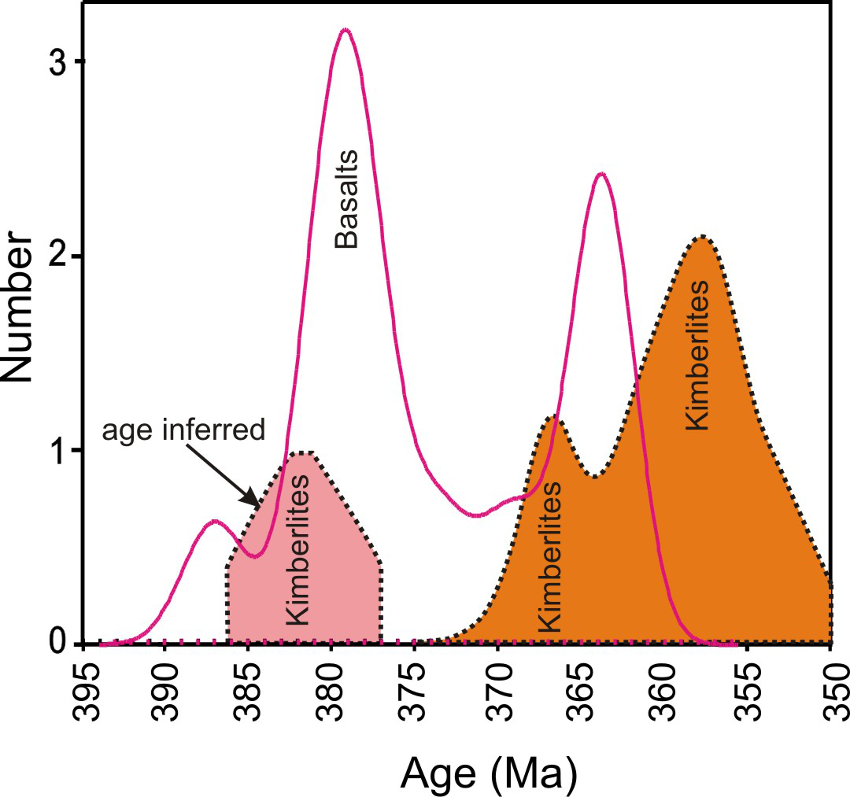
Figure 3: Temporal relation between mafic and kimberlitic magmatism of the Y-V LIP. Data for the Y-V LIP is represented by 40Ar/39Ar age compilations (Table 2). Whereas data for kimberlites are SHRIMP U-Pb ages on perovskites from Kinny et al. (1997). To plot the age probability histogram, errors for the 40Ar/39Ar ages were set to 1% unless the analytical error exceeds this value.
Geodynamic setting
Fig. 4 shows paleogeographic reconstruction (Domeier and Torsvik, 2014) in Devonian (390 Ma) time, when the Siberian continent was bounded to the paleo-South by a subduction system involving recycling of the Rheic Ocean and to the paleo-North and to the paleo-West by spreading systems of the Mongolia-Okhotsk Ocean. However, further to the paleo-North and to the paleo-West there were other subduction systems and thus, in a broader sense, the Siberian continent was surrounded by the Devonian subduction systems from every side. Distances from the reconstructed paleo-arcs to the margins of the Y-V LIP varied from about 1 to 2 thousand km. In the late Devonian, the Siberian continent was characterized by another volcanic activity, named the Altai-Sayan Province (Vorontsov and Sandimirov, 2010; Vorontsov et al., 2013) located closer to the continental boundary (Fig. 1).
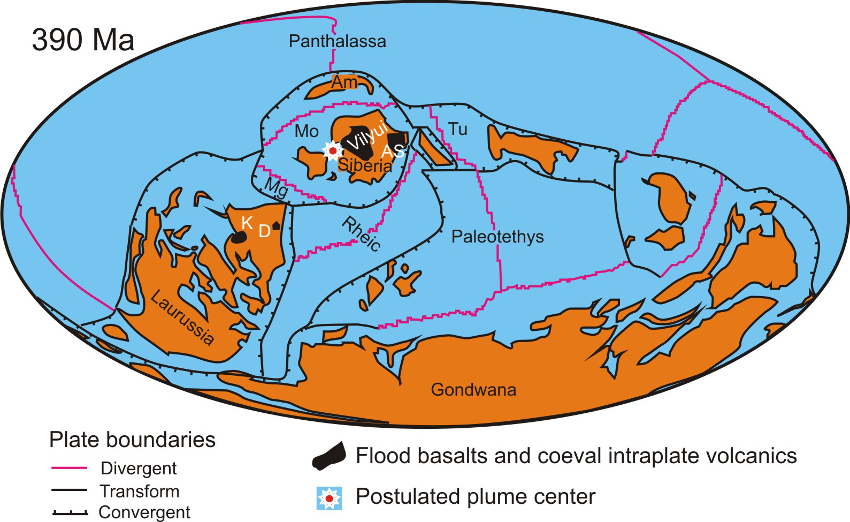
Figure 4: Paleogeographic reconstructions for 390 Ma (Domeier and Torvik, 2014), thus about 20 Ma before major phase of the Y-V LIP magmatism. Other flood basalt and intracontinental volcanic provinces are Donbass (D, ~370 Ma) and Kola (K, ~370 Ma), (grouped as the Kola-Dnieper LIP; Ernst, 2014) and Altai-Sayan (AS, ~360 Ma). Acronyms: Am – Amurian superterrane, Mg – Magnitogorsk arc, Mo – Mongolia-Okhotsk Ocean and Tu – Turkestan Ocean. Names in white and black are for the volcanic provinces and plates, respectively. Postulated plume center for the Y-V LIP is after (Kiselev et al., 2012). According to Donskaya et al. (2013) subduction of the Mongolia-Okhotsk oceanic slab beneath Siberia could start in the Middle Devonian, however Domeier and Torvik (2014) consider that subduction of this slab started later in the Early Carboniferous.
Models
Emplacement of diamond-bearing kimberlites after mafic volcanism requires the lithospheric mantle to be thick during and after the mafic Y-V LIP magmatism. Thickness of the lithospheric mantle of the Siberian Craton in the Devonian was estimated from PT data on the kimberlite-entrained mantle xenoliths to be 190-230 km depending on location (Griffin et al., 1999). Such thick lithosphere would prevent melting of a dry lower mantle plume right underneath the Y-V LIP (Ivanov, in press). There are three potential models, which can explain the Y-V LIP:
(1) Kiselev et al. (2012) note radial distribution of dykes and rifts and assume that they can be traced to the same plume centre located outside the Siberian Craton (Fig. 1, Fig. 4). According to that model, mafic melts laterally propagated for hundreds and thousands kilometers from an area of thin lithosphere into area of the thick cratonic lithosphere (Fig. 5) (Ernst, 2014).
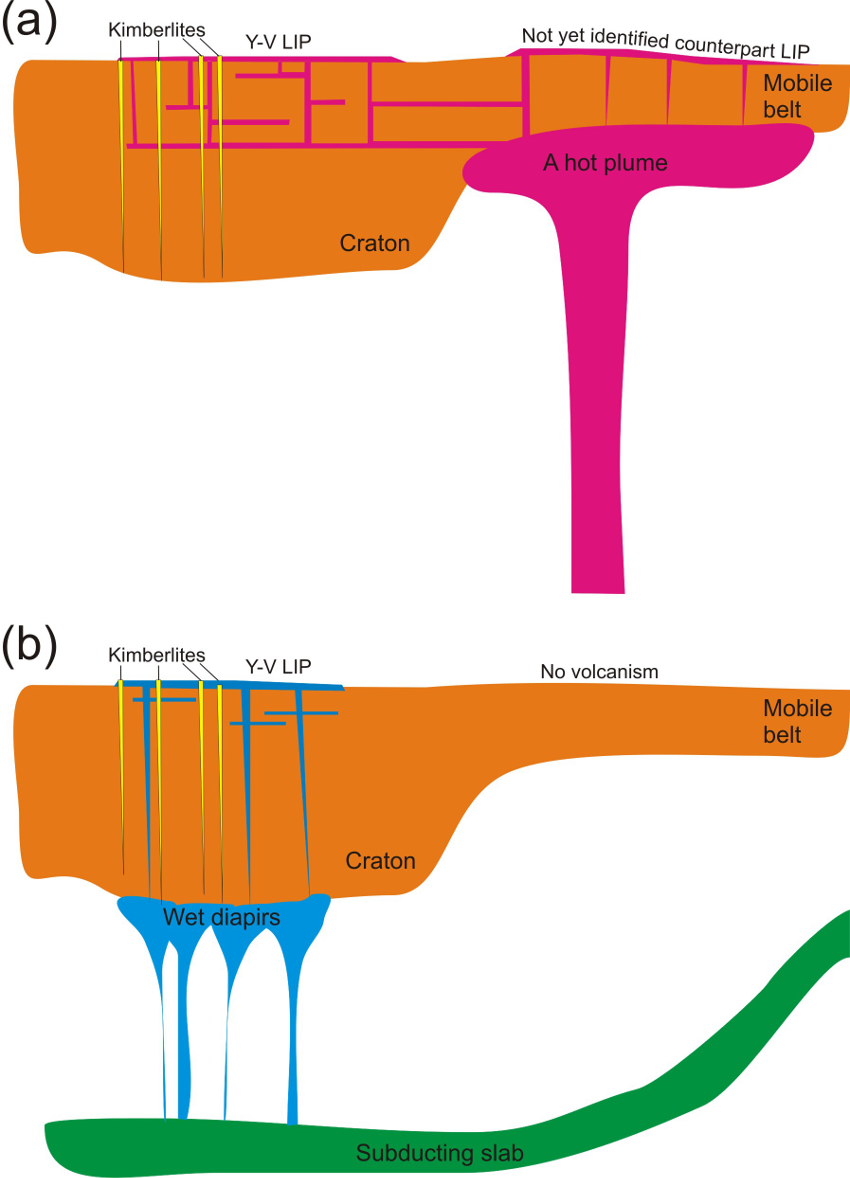
Figure 5: Two potential models for the origin of Y-V LIP magmatism discussed in literature linking the magmatism to (a) a remotely located plume center via dyke swarms (e.g. Ernst, 2014) and (b) assuming fluxing of the subcratonic lithosphere by volatiles to lower the mantle solidus (Ivanov, in press).
(2) Ivanov (in press; http://www.mantleplumes.org/DLABook/Ivanov_Accepted.pdf) argues that melting occurred underneath cratonic lithosphere and was associated with deep (transition zone) dehydration of subducted slabs, similarly to a model suggested for the Permian-Triassic Siberian large igneous province (Ivanov and Litasov, 2014; see also a model of subduction associated asthenospheric flow of Wang et al., in press; http://www.mantleplumes.org/SupercontinentAssemblyLIPs.html).
(3) Another, not yet considered in literature for that particular large igneous province, model associates the Y-V LIP magmatism to the melting of fusible metasomatically modified by previous geologic processes lithospheric mantle (e.g., Puffer, 2001).
References
Bryan, S., and Ernst, R., 2008, Revised definition of large igneous provinces (LIPs): Earth-Science Reviews, v. 86, p. 175-202.
Cocks, L.R.M., and Torsvik, T.H., 2007, Siberia, the wandering northern terrane, and its changing geography through the Paleozoic: Earth-Science Reviews, v. 82, p. 29-74.
Courtillot, V., Kravchinsky, V.A., Quidelleur, X., Renne, P.R., and Gladkochub, D.P., 2010, Preliminary dating of the Viluy traps (Eastern Siberia): eruption at the time of Late Devonian extinction events?: Earth and Planetary Science Letters, v. 300, p. 239–245.
Domeier, M., and Torsvik, T.H., 2014, Plate tectonics in the late Paleozoic: Geoscience Frontiers, v. 5, p. 303-350.
Donskaya, T.V., Gladkochub, D.P., Mazukabzov, A.M., and Ivanov, A.V., 2013, Late Paleozoic – Mesozoic subduction-related magmatism at the southern margin of the Siberian continent and the 150-million-year history of the Mongolia-Okhotsk Ocean: Journal of Asian Earth Sciences, v. 62, p. 79–97.
Ernst, R.E., 2007, Mafic-ultramafic large igneous provinces (LIPs): Importance of the Pre-Mesozoic record: Episodes, v. 30, p. 108-114.
Ernst, R.E., 2014, Large Igneous Provinces: Cambridge, Cambridge University Press, 653 p.
Ernst, R.E., Pereira, E., Hamilton, M.A., Pisarevsky, S.A., Rodriques, J., Tassinari, C.C.G., Teixeira, W., Van-Dunem, V., 2013, Mesoproterozoic intraplate magmatic “barcode” record of the Angola portion of the Congo craton: newly dated magmatic events at 1500 and 1110 Ma and implications for Nuna supercontinent reconstructions. Precambrian Research, v. 230, p. 103–118.
Ernst, R.E., Hamilton, M.A., Kamo, S.L., Okrugin, A.V., Veselovskiy, R.V., Pavlov, V., Söderlund, U., and Chamberlain, K.R., 2014, The 1498-1503 Ma Kuonamka LIP of northern Siberia: new precise U-Pb baddeleyite dating?: GAC-MAC annual meeting, Fredericton, New Brunswick, May 21-23.
Gladkochub, D.P., Pisarevsky, S.A., Donskaya, T.V., Natapov, L. M., Mazukabzov, A.M., Stanevich, A.M., and Sklyarov, E.V., 2006, Siberian Craton and its evolution in terms of Rodinia hypothesis: Episodes, v. 29, p. 169–174.
Gladkochub, D.P., Pisarevsky, S.A., Donskaya, T.V., Ernst, R.E., Wingate, M.T.D., Söderlund, U., Mazukabzov, A.M., Sklyarov, E.V., Hamilton, M.A., and Hanes, J.A., 2010, Proterozoic mafic magmatism in Siberian craton: an overview and implications for paleocontinental reconstruction: Precambrian Research, v. 183, p. 660–668.
Griffin, W.L., Ryan, C.J., Kaminsky, F.V., O’Reilly, S.Y., Natapov, L.M., Win, T.T., Kinny, P.D., and Ilupin, I.P., 1999, The Siberian lithosphere traverse: mantle terranes and the assembly of the Siberian craton: Tectonophysics, v. 310, p. 1–35.
Ivanov, A.V., in press, Why volatiles are required for cratonic flood basalt volcanism: Two examples from the Siberian Craton, in Foulger, G.R., Lustrino, M., and King, S., eds., The Interdisciplinary Earth: A volume in honor of Don L. Anderson. GSA & AGU.
Ivanov, A.V., Demonterova, E.I., and Lebedev, V.A., 2012, Basaltic volcanism in the Sharyzhalgai block of the Siberian craton with the age of one billion years: Geodynamic evolution of lithosphere of the Central-Asian mobile belt: From an ocean to the continent, Irkutsk, Russia, issue 10, volume 1, p. 96-97, 17-20 October.
Ivanov, A.V., He, H., Yan, L., Ryabov, V.V., Shevko, A.Y., Palesskii, S.V., and Nikolaeva, I.V., 2013, Siberian Traps Large Igneous Province: Evidence for two flood basalt pulses around the Permo-Triassic boundary and in the Middle Triassic, and contemporaneous granitic magmatism: Earth-Science Reviews: v. 122, p. 58–76.
Ivanov, A.V., and Litasov, K.D., 2014, The deep water cycle and flood basalt volcanism: International Geology Review, v. 56, p. 1–14.
Kinny, P.D., Griffin, B.J., Heaman, L.M., Brakhfogel, F.F., and Spetsius, Z.V., 1997, SHRIMP U-Pb ages of perovskite from Yakutian kimberlites: Geologiya i geofizika, v. 38, p. 91-99.
Kiselev, A.I., Ernst, R.E., Yarmolyuk, V.V., and Egorov, K.N., 2012, Radiated rifts and dyke swarms of the Middle Paleozoic Yakutsk plume of eastern Siberian craton: Journal of Asian Earth Science, v. 45, p. 1-16.
Kiselev, A.I., Yarmolyuk, V.V., Ivanov, A.V., and Egorov, K.N., 2014, Middle Paleozoic basaltic and kimberlitic magmatism in the northwestern shoulder of the Vilyui rift, Siberia: relations in space and time: Russian Geology and Geophysics, v. 55, 143–151.
Li, Z.X., et al., 2008, Assembly, configuration, and break-up history of Rodinia: A synthesis: Precambrian Research, v. 160, p. 179–210.
McDonough, W.F., and Sun, S.-S., 1995, The composition of the Earth: Chemical Geology, v. 120, p. 223-253.
Powerman, V., Shatsillo, A., Coe, R., Zhao, X., Gladkochub, D., Buchwaldt, R., and Pavlov, V., 2013, Palaeogeography of the Siberian platform during middle Palaeozoic Times (~450–400 Ma): new palaeomagnetic evidence from the Lena and Nyuya rivers: Geophysical Journal International, v. 194, p. 1,412-1,440.
Puffer, J.H., 2001, Contrasting high filed strength element content of continental flood basalts from plume versus reactivated-arc sources: Geology, v. 29, p. 675-678.
Renne, P.R., Mundil, R., Balco, G., Min, K., and Ludwig, K.R., 2010, Joint determination of 40K decay constants and 40Ar*/40K for the Fish Canyon sanidine standard, and improved accuracy for 40Ar/39Ar geochronology: Geochimica et Cosmochimica Acta, v. 74, p. 5,349–5,367.
Renne, P.R., Balco, G., Ludwig, K.R., Mundil, R., and Min, K., 2011, Response to the comment by W.H. Schwarz et al. on “Joint determination of 40K decay constants and 40Ar*/40K for the Fish Canyon sanidine standard, and improved accuracy for 40Ar/39Ar geochronology” by P.R. Renne et al. (2010). Geochimica et Cosmochimica Acta, v. 75, p. 5,097–5,100.
Ricci, J., Quidelleur, X., Pavlov, V., Orlov, S., Shatsillo, A., and Courtillot, V., 2013, New 40Ar/39Ar and K-Ar ages of the Viluy traps (Eastern Siberia): Further evidence for a relationship with the Frasnian-Famennian mass extinction: Palaeogeography, Palaeoclimatology, Palaeoecology, v. 386, p. 531-540.
Rojas-Agramonte, Y., Kröner, A., Demoux, A., Xia, X., Wang, W., Donskaya, T., Liu, D., and Sun, M., 2011, Detrital and xenocrystic zircon ages from Neoproterozoic to Palaeozoic arc terranes of Mongolia: Significance for the origin of crustal fragments in the Central Asian orogenic belt: Gondwana Research, v. 19, p. 751–763.
Rosen, O.M., Condie, K.C., Natapov, L.M., and Nozhkin, A.D., 1994, Archean and early Proterozoic evolution of the Siberain Craton: A preliminary assessment, in Condie, K.S., ed., Archean Crustal Evolution, Elsevier, Amsterdam, p. 411-459.
Savel’eva, V.B., Danilova, Yu.V., Bazarova, E.P., Ivanov, A.V., and Kamenetsky, V.S., in press. Carbonatite magmatism of the southern Siberian Craton at 1 Ga – evidence for Laurasia breakup in the early Neoproterozoic: Doklady Earth Sciences.
Smelov, A.P., and Timofeev, V.F., 2007, The age of the North Asian Cratonic basement: An overview: Gondwana Research, v. 12, p. 279-288.
Vorontsov, A.A., Fedoseev, G.S., and Andryushchenko, S.V., 2013, Devonian volcanism in the Minusa basin in the Altai-Sayan area: geological, geochemical, and Sm-Nd isotopic characteristics of rocks: Russian Geology and Geophysics, v. 54, p. 1001-1025.
Vorontsov, A.A., and Sandimirov, I.V., 2010, The Devonian magmatism in the Kropotkin Ridge (East Sayan) and sources of basites: geological, geochemical, and Sr-Nd isotope data. Russian Geology and Geophysics, v. 51, p. 833-845.
Wang, Y., Santosh, M., Luo, Z., and Hao, J., in press, Large igneous provinces linked to supercontinent assembly: Journal of Geodynamics.
Yarmolyuk, V.V., Litvinovsky, B.A., Kovalenko, V.I., Jahn, B.M., Zanvilevich, A.N., Vorontsov, A.A., Zhuravlev, D.Z., Posokhov, V.F., Kuz’min, D.V., and Sandimirova, G.P., 2001, Formation stages and sources of the peralkaline granitoid magmatism of the Northern Mongolia–Transbaikalia rift belt during the Permian and Triassic: Petrology, v. 9, p. 302–328.